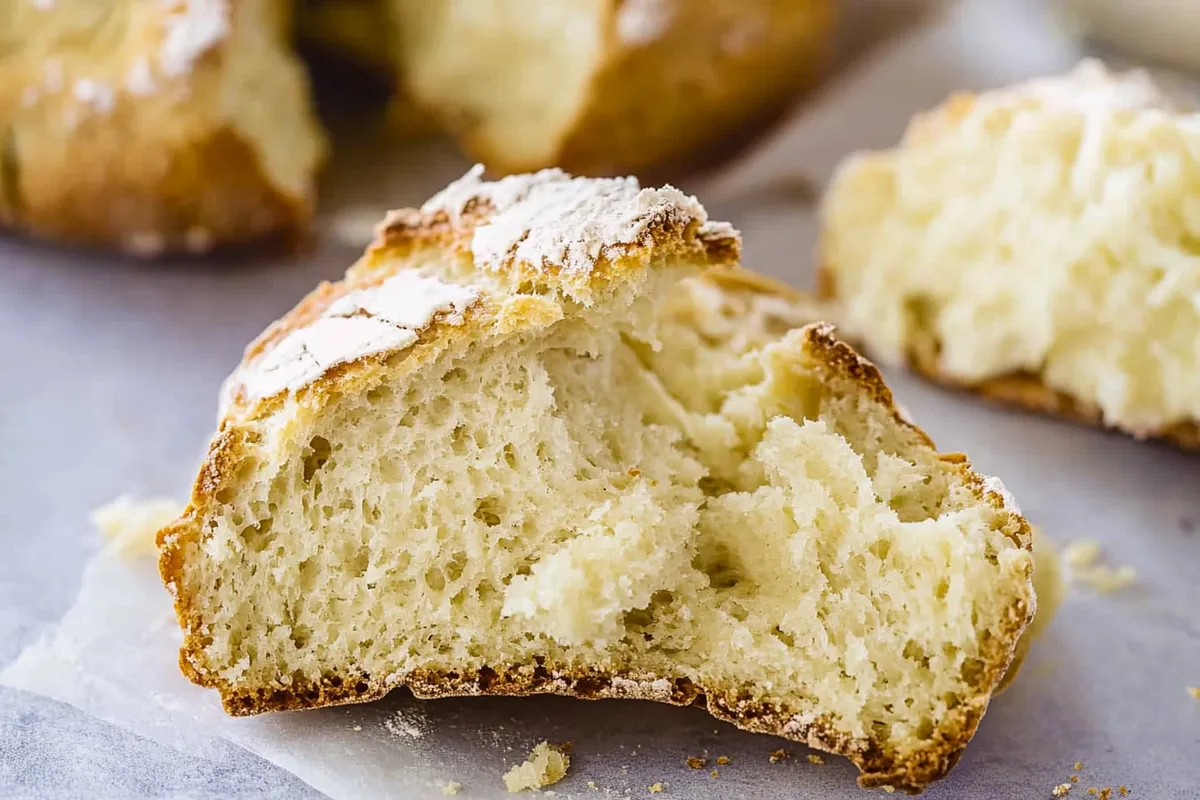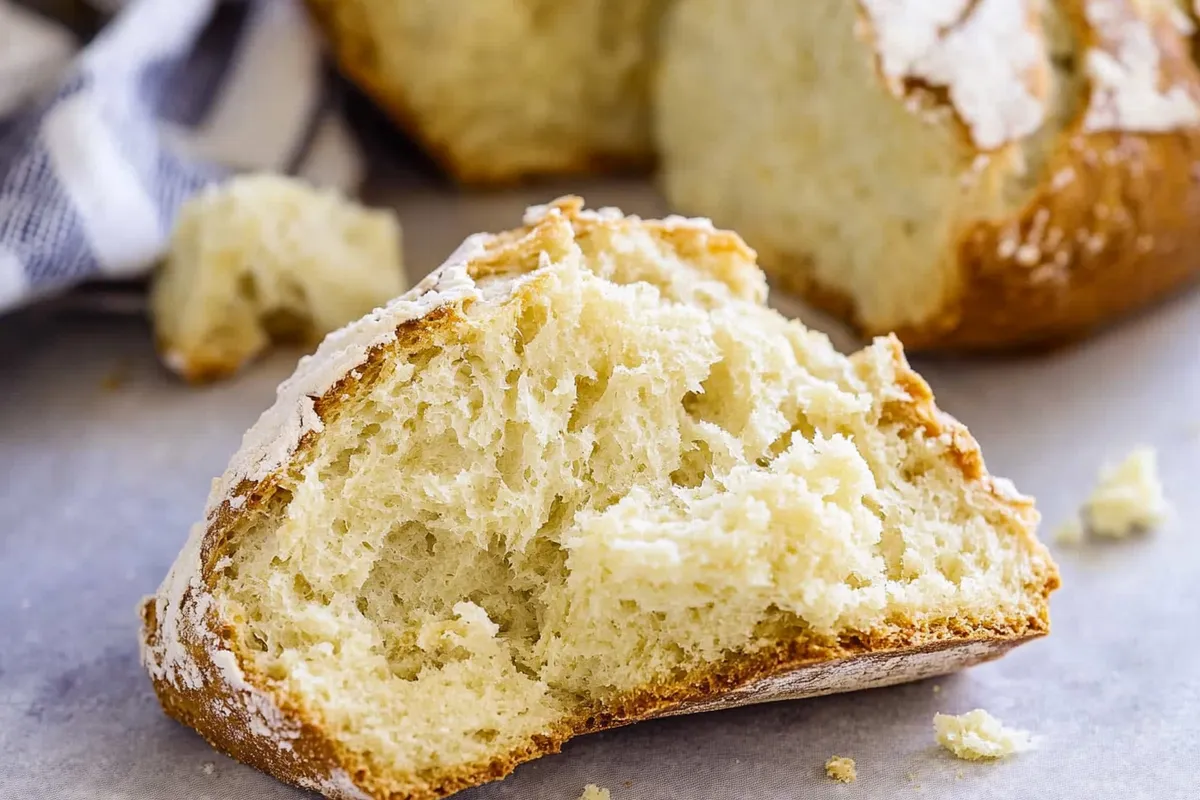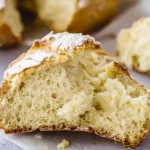Traditional Irish Soda Bread: A Quick and Easy Recipe

Few baked goods can capture the heart quite like Traditional Irish Soda Bread, a delightful staple that’s both simple and satisfying. With its distinctive crust and tender crumb, it’s no wonder this bread has warmed the tables of families for generations. Made using just a handful of ingredients, including flour, baking soda, buttermilk, and salt, the beauty of this bread lies in its endless variations. Imagine adding tangy raisins for sweetness or caraway seeds for a touch of spice—the possibilities are as endless as your imagination!
To achieve the perfect loaf, precision is key; the right balance of ingredients and the right techniques can elevate your baking game. Be mindful of how you handle the dough—too much kneading can lead to a dense texture. Allow your creativity to flourish by experimenting with additional flavors or by shaping it into festive forms for special occasions. This easy-to-make bread not only offers delicious results but also invites everyone to gather around the kitchen, sharing stories while savoring the warm, comforting aroma of freshly baked bread.
Ingredients for Traditional Irish Soda Bread:
This classic Irish bread is known for its simplicity and delightful flavor. Below are the precise ingredients you will need to prepare a delicious loaf that serves 8-10 people.
For the Base Ingredients:
- 4 cups (500g) all-purpose flour
- 1 teaspoon baking soda
- 1 teaspoon salt
- 1 ¾ cups (420ml) buttermilk
For Optional Add-ins:
Feel free to enhance the flavor and texture of your soda bread by incorporating any of the following optional ingredients:
- 1 cup (150g) raisins or currants – for a touch of sweetness.
- 1 tablespoon caraway seeds – to add a characteristic flavor.
- ½ cup (60g) grated cheddar cheese – for a savory twist.
- 2 tablespoons chopped fresh herbs (like dill or parsley) – for a fresh herbal note.
- 1/4 cup (25g) chopped nuts (like walnuts or hazelnuts) – to add crunch and texture.
For a Richer Flavor (Optional):
To give your soda bread an even richer taste, you might consider these options:
- Replacing half of the all-purpose flour with whole wheat flour – for added nutrition and a nutty flavor.
- Using 1/4 cup (60ml) of honey or maple syrup in place of a portion of the buttermilk – for a subtly sweet touch.
- Incorporating Zest from 1 lemon or orange – for a citrusy kick.
Tools and Equipment:
While the ingredients are vital, having the right tools makes baking much easier. Gather the following:
- Large mixing bowl
- Wooden spoon or dough scraper
- Baking sheet lined with parchment paper
- Sharp knife or bread lame (for scoring the bread)
- Oven preheated to 425°F (220°C)
With these ingredients and optional enhancements, you’re all set to create a great loaf of soda bread that brings a piece of Irish tradition right to your table!

How to prepare Traditional Irish Soda Bread:
Making Traditional Irish Soda Bread is a straightforward process that requires minimal ingredients and equipment. Follow these steps to create a delicious loaf.
Gather Your Ingredients
Start by collecting all the necessary ingredients. You’ll need 4 cups of all-purpose flour, 1 teaspoon of baking soda, 1 teaspoon of salt, and 1 and ½ cups of buttermilk. Measure each ingredient accurately for the best results.
Preheat Your Oven
Before mixing the ingredients, preheat your oven to 425°F (220°C). This ensures that the bread bakes evenly and rises properly once it goes into the oven.
Mix the Dry Ingredients
In a large mixing bowl, combine the flour, baking soda, and salt. Use a whisk to blend everything thoroughly. This step is crucial for distributing the baking soda evenly throughout the flour.
Add the Buttermilk
Make a well in the center of the dry mixture. Pour in the buttermilk gradually while stirring with a wooden spoon or your hand. This creates a sticky dough. Be careful not to overmix, as this can lead to a dense loaf.
Knead the Dough
Transfer the dough onto a floured surface. Lightly knead it about 4 to 5 times, just until it forms a cohesive ball. Remember, over-kneading can result in a tough texture.
Shape the Loaf
Shape the dough into a round loaf, about 1 to 2 inches thick. Place it onto a baking sheet lined with parchment paper. Ensure any excess flour is brushed off to avoid burning.
Score the Dough
Using a sharp knife, make a deep cross on top of the loaf. This allows for even rising during baking and creates an appealing crust. It also helps to release steam from inside the bread.
Bake the Bread
Once your oven is ready, place the baking sheet inside. Bake the soda bread for 30 to 35 minutes until it turns golden brown and sounds hollow when tapped on the bottom. This indicates that it’s fully cooked.
Cool Before Slicing
After baking, remove the bread from the oven and let it cool on a wire rack. Allow it to cool for at least 10 minutes before slicing to maintain its texture. Enjoy your freshly baked loaf!
Tips for the Perfect Traditional Irish Soda Bread
Creating the ideal loaf of soda bread requires attention to detail and a few useful tricks. With these tips, your homemade bread will be fluffy, moist, and bursting with flavor.
Quality Ingredients for the Best Results
Choose high-quality ingredients. Use fresh, unbleached all-purpose flour for a robust texture. Look for a reliable baking soda brand, as this is the primary leavening agent. Avoid older baking soda, which may lose its potency over time. Buttermilk is essential; it adds moisture and a distinctive flavor profile to your loaf. If you cannot find buttermilk, you can create a substitute by adding one tablespoon of vinegar or lemon juice to a cup of milk and letting it sit for about 5-10 minutes until it thickens.
Maintaining the Correct Temperature
Temperature plays a crucial role in baking. Use room temperature ingredients, especially buttermilk. This ensures the baking soda reacts properly, allowing the dough to rise optimally. If your kitchen is too cool, warm the buttermilk slightly before mixing. Preheat the oven to 425°F (220°C) to guarantee a crusty exterior. Placing the bread in a preheated oven allows for maximum rise.
Simple Mixing Techniques
Mix the ingredients gently. Overworking the dough can lead to a tough loaf. Combine the dry ingredients first, then add the wet ingredients in one go. Stir until the mixture just comes together, and don’t worry about small lumps. They will disappear during baking.
Creative Variations and Dietary Substitutions
If you want to experiment, consider adding ingredients like raisins, caraway seeds, or herbs for added flavor. For gluten-free options, use a 1:1 gluten-free flour blend but ensure it includes xanthan gum for binding. Those with dairy restrictions can substitute almond milk mixed with vinegar as an effective alternative. You may adjust the sweetness by including a bit of sugar, honey, or molasses if desired, tailoring it to your taste.
Storing and Serving Your Bread
After baking, allow the bread to cool on a wire rack to prevent sogginess. Store it in an airtight container at room temperature for up to two days. If you need to keep it longer, slice and freeze half or more of it. This way, you can enjoy slices of fresh soda bread whenever you want.
With this advice, you are well on your way to mastering soda bread making. Enjoy the process, and don’t hesitate to adapt the recipe to suit your preferences.
Storage Tips for Traditional Irish Soda Bread:
Keeping your traditional Irish soda bread fresh requires the right storage techniques. Follow these tips to maintain its delicious taste and texture for as long as possible.
1. Cool Before Storing
Always cool the bread completely before storage. Place it on a wire rack to let air circulate around it. If you store warm bread, moisture will accumulate, leading to sogginess and mold.
2. Use a Bread Box or Cloth
For short-term storage, place the loaf in a bread box or wrap it in a clean kitchen cloth. This approach keeps the crust crisp while allowing the loaf to breathe. Avoid plastic wrap, as it traps moisture and can lead to a rubbery texture.
3. Seal for Longer Storage
If you plan to store the bread for more than a few days, consider freezing it. Slice the loaf into desired portions for easier access. Wrap each piece tightly in plastic wrap, then place them in a zip-top freezer bag. Removing as much air as possible will help prevent freezer burn.
4. Refrigeration Is Not Recommended
Refrigerating soda bread is generally not a good idea. The cool temperature can dry it out and change its texture. If you need to keep the bread fresh for more than three days, prefer freezing over refrigeration.
5. Thawing and Reheating
To enjoy frozen soda bread, remove the desired slices and let them thaw on the counter for 30 minutes. If you prefer warm bread, use an oven. Preheat the oven to 350°F (175°C). Place the bread (still wrapped) directly in the oven for about 10-15 minutes. This method will revitalize the loaf, restoring that fresh-baked aroma and taste.
6. Shelf Life Insights
When stored properly at room temperature, traditional Irish soda bread lasts about 2 to 3 days. If you keep it in the freezer, it can last up to 3 months without losing quality. Always check for signs of spoilage, like an off smell or visible mold, before consuming.
By following these storage tips, you will ensure that your traditional Irish soda bread remains a delightful treat, ready to enhance any meal or snack time.
Related Recipes for Your Baking Pleasure
If you enjoy Traditional Irish Soda Bread, you’ll appreciate these complementary recipes. They share similar ingredients, baking techniques, or flavor profiles, making them perfect companions for your next meal.
1. Buttermilk Pancakes
These fluffy pancakes use buttermilk, just like soda bread. The acidity in buttermilk reacts with baking soda, creating a tender texture in both recipes. Serve them with maple syrup or fresh fruit for a delightful breakfast that echoes the comfort of traditional bread.
2. Irish Brown Bread
Irish brown bread, a close cousin to soda bread, features whole wheat flour for a nuttier flavor. This bread is drier than its white counterpart and offers a robust taste that pairs well with soups or stews. Enjoy it slathered with butter or as a side to a hearty meal.
3. Soda Bread Scones
Soda bread scones transform the standard recipe into a sweeter treat. Adding dried fruits like currants or cranberries gives these scones a fruity kick. They make excellent snacks or breakfast items alongside tea, reminiscent of the classic love for soda bread.
4. Savory Cheddar and Herb Scones
These scones incorporate cheese and herbs for a savory twist. Like soda bread, they rely on baking soda for leavening. The aromatic herbs combined with sharp cheese create a flavor bomb that serves well with soups or salads, echoing that comforting warmth.
5. Traditional Irish Stew
Although not a bread, this hearty stew pairs beautifully with any soda bread. The rich, meaty broth filled with potatoes and carrots enhances the bread’s taste. Dipping slices of soda bread into this comforting stew provides a wonderful culinary experience that celebrates Irish flavors.
These recipes not only complement the experience of enjoying soda bread but also allow for creativity in your kitchen. Experimenting with various textures and flavors will elevate your meal to new heights while celebrating the spirit of traditional Irish cooking.
Frequently Asked Questions:
What is Traditional Irish Soda Bread made of?
Traditional Irish Soda Bread primarily consists of flour, baking soda, salt, and buttermilk. The simplicity of these ingredients is what makes this bread unique. The reaction between baking soda and buttermilk creates a light and fluffy texture, distinguishing it from other types of bread that rely on yeast for rising. The flour used can vary, with some recipes incorporating whole wheat or added seeds for extra flavor and nutrition.
How is soda bread different from regular bread?
The key difference between soda bread and regular bread lies in the leavening agent. While traditional bread is typically leavened with yeast, soda bread uses baking soda as its leavening agent. This not only speeds up the bread-making process but also results in a denser texture. The choice of buttermilk as an ingredient contributes to its signature taste, giving it a slight tanginess that is characteristic of this iconic Irish staple.
Can you add ingredients to Traditional Irish Soda Bread?
Absolutely! While the classic recipe is quite simple, many variations include additional ingredients. Popular additions include raisins, currants, or even herbs and seeds. Incorporating these elements can enhance the flavor profile and provide a delightful twist on the traditional recipe. Be mindful that adding too many ingredients can affect the bread’s texture and rise, so it’s advisable to maintain balance.
How do you store Irish soda bread?
Storing soda bread correctly is crucial to preserving its freshness. Ideally, it should be wrapped tightly in a clean kitchen towel or placed in an airtight container at room temperature. This method helps to maintain its soft texture. If you have leftover bread, it can be frozen for up to three months, wrapped securely to prevent freezer burn. When ready to enjoy, simply thaw and toast it for the best results.
Why does my soda bread not rise well?
If you notice that your soda bread isn’t rising as expected, it might be due to a few factors. The freshness of your baking soda is essential; if it’s too old, it may not produce the desired reaction with your wet ingredients. Also, ensure that you’re measuring your flour accurately, as too much flour can lead to a heavy dough. Remember that mixing too vigorously can also affect the rise, so combine your ingredients gently.
Is Traditional Irish Soda Bread healthy?
Soda bread can be a healthier option compared to other types of bread, particularly when made with whole grain flour. It is lower in sugar and often contains more fiber, especially when incorporating whole wheat flour. The use of buttermilk adds calcium and probiotics, contributing to its nutritional benefits. However, as with any bread, moderation is key, especially if you’re watching your carbohydrate intake.
Conclusion:
In summary, crafting Traditional Irish Soda Bread is a delightful and straightforward process that celebrates authenticity and culinary simplicity. Emphasizing the use of simple ingredients, this versatile bread allows for countless customization options, from adding raisins or nuts to incorporating whole wheat flour for an earthy twist. Its quick preparation will have fresh bread on your table in no time, making it an ideal option for both experienced bakers and novices alike. Don’t hesitate to experiment with your favorite mix-ins or to tailor the recipe to suit dietary preferences. By embracing the flexible nature of this classic loaf, you’re not only honoring tradition but also creating a personal and memorable dish. Enjoy the warm, comforting aroma and the delectable taste with every slice, and let this staple become a cherished part of your baking repertoire.
Print
Traditional Irish Soda Bread: A Quick and Easy Recipe
- Total Time: 45 minutes
- Yield: 1 loaf (about 8 servings) 1x
Description
This classic Irish soda bread is simple, rustic, and requires no yeast! With a crisp crust and tender crumb, it’s the perfect companion to soups, stews, or a generous spread of butter.
Ingredients
- 4 cups all-purpose flour
- 1 ½ tsp baking soda
- 1 tsp salt
- 1 ¾ cups buttermilk
Instructions
- reheat & Prep: Preheat oven to 220°C (425°F). Line a baking sheet with parchment paper.
- Mix Dry Ingredients: In a bowl, whisk together flour, baking soda, and salt.
- Add Buttermilk: Gradually mix in buttermilk until a dough forms.
- Shape & Score: Knead lightly, shape into a round loaf, and place on the baking sheet. Cut a deep “X” on top.
- Bake: Bake for 30-35 minutes until golden brown. Let cool before slicing.
Notes
- For a softer crust, wrap the bread in a damp towel after baking.
- Add raisins or caraway seeds for a sweeter variation.
- Best enjoyed fresh but can be stored for up to 2 days.
- Prep Time: 10 minutes
- Cook Time: 35 minutes
Nutrition
- Calories: 180 kcal
- Fat: 1g
- Carbohydrates: 35g
- Fiber: 1g
- Protein: 5g
